Amazon Series Dianthus (Dianthus barbatus) for the Farmer Florist
Dianthus (Dianthus barbatus interspecific) flowers are in the same genus as carnations (D. caryophyllus) and “cousins” to old-fashioned garden pinks. Many can spot the similarities between the blooms. Dianthus flowers are also known by their common name Sweet William. These flowers make a splash in floral arrangements and bouquets due to their color and size of their flower head.
In production, they enjoy the cooler seasons of the Mississippi year, yet can flower amazingly well in the summer heat. They are available in a myriad of colors, including solid and multi options. New varieties with robust flowering have entered the marketplace in recent years. Although the dianthus flower is a perennial, it is grown as an annual to market larger cut flowers from floriferous plants.
This plant offers terrific filler flowers for bouquets and arrangements. They also stand on their own as a colorful specialty cut flower and are long-lasting in designs. They are a cool-season favorite, and new varieties offer months of cut flowers. The first cut offers larger flower heads while later cuts have smaller heads, but there are many of them.
Production
Production from transplants is recommended. To start transplants, sow seeds 6-8 weeks before the last frost in your area. Lightly sow seed into your preferred growing medium. Light is required for germination, which should occur in 3–9 days. Transplant seedlings into cell packs or 3-4 inch containers 20-25 days after sowing. Harden off and transplant 6-8 weeks after sowing. Soil temperature should range from 64 to 70˚F. For best production, daytime temperatures should range from 50 to 72˚F and nighttime temperatures should range between 40 and 60˚F. Seed to mature stem ranges from 115 to 125 days.
Dianthus prefers slightly alkaline, well-drained beds amended with organic matter. Plant in full sun and do not allow soil to remain wet. Some growers space plants at 6- 8-inch centers, but 4-inch spacing also successfully produces tall, straight stems. A layer of support netting (HortNova or similar) is necessary for outdoor, high tunnel, and greenhouse production.
Diseases and Pests
Although we have seen few pest issues, dianthus is not immune to fungal and bacterial diseases nor insect infestations. Click here for more pest and disease information.
Root and crown rots, Rhizoctonia solani, Pythium
The above ground symptoms of root and crown rots are non-specific and include a general wilting, decline, and collapse of the foliage and the entire plant. This general droopiness or flaccid appearance is often accompanied by browning and rotting of the roots and the crown. Yellowing and death of the outer leaves follows, until finally the entire plant is dead. It is helpful to avoid overwatering, especially in heavy soils, and to avoid watering directly into the crown area of the plant. Highly symptomatic plants should be removed since recovery is unlikely.
Bacterial wilt (Pseudomonas)
Primary symptoms of infection include wilting of plants or shoots as well as splitting of the stems and frayed yellow streaks in the vascular system. Tissue just under the epidermis is sticky, and cutting across the stem shows discoloration and a bacterial ooze. The disease appears to spread rapidly at high temperatures. Remove symptomatic plants, avoid overhead irrigation, and splashing water. Infected plants should not be composted. Sanitation is also very important since this disease is easily spread. All equipment should be disinfected between use with 10 percent household bleach, 70 percent alcohol, or a commercially available sanitizer labeled for agricultural use.
Aphids (Myzus persicae and Aphis helichrysi)
The green peach aphid and the leaf curl plum aphid, Aphis helichrysi, infest the young leaves and buds, suck the sap, and are often troublesome in greenhouses. When needed, insecticidal soap or ultra-fine horticultural oil will be effective against aphids.
For chemical controls, refer to CDMS and Green Book.
Harvest and Handling
Stems are ready to harvest when 10 to 20 percent of flowers in the cluster or spray are open. Cut the first central flowering stem as low as possible, just above the first side shoots. This will allow the side shoots to grow and mature into quality cut flowers. They will be a bit smaller than that first-cut bloom, but highly marketable.
Cultivar Recommendations
Varieties in the Amazon series produce large, bright flower heads that contrast with the dark green, glossy foliage. Shown in the examples below are stems of Amazon ‘Rose Magic’, which blooms white, aging to pink, rose, and then deep rose. All color ranges show up on each flower head. Other varieties in the Amazon series include ‘Neon Purple’ (violet-purple blooms) ‘Neon Cherry’ (bright neon cherry blooms), and ‘Neon Duo (mixed violet-purple and cherry blooms). Dianthus bloom the first year and produce 5–7 stems that can reach to 36 inches long. The stems are thick and strong, supporting large blooms. For each variety, all colors are visible on individual flower heads. Amazon series dianthus flowers have a long vase life. In Zones 6–8, these perform as a tender perennial and are best grown as annuals.
Design Applications
Both large-headed dianthus and the later, smaller-headed cuts have numerous applications for a variety of floral designs. We feel they stand on their own as a cut flower and have created some contemporary design uses for weddings and events.
Flowers to Carry
Dianthus Bridesmaid’s Bouquet
This project requires approximately:
- 10 stems of dianthus
- 1-2 stems ivy (Hedera helix ‘Glacier’)
- 1 stem plumosa fern (Asparagus setaceus)
- 1 stem water oak (Quercus nigra)
- 5 midollino sticks (wicker)
- bullion wire
If you do not have access to these plant materials or supplies, substitute similar items. Midollino sticks and bullion wire are found through floral and craft suppliers.
Unwind approximately 6-10 yards of the bullion wire, roll it into a meatball shape, then flatten the ball between your hands. Use the flattened wire to bind the midollino sticks into a circle of concentric, asymmetric rings. This binding method is much quicker than wrapping the wire many times and provides the same effect. You can use the same ball/flatten/wrap method at the ends of the sticks, then overwrap with extra bullion to secure the wire in place to create a sparkling finish.
The midollino structure acts as a trellis or lightweight armature to hold the fresh plant material in place. Lightly wind the ivy and plumosa stems around the outer ring of the pattern. Use bullion wire to secure in place, if necessary, but keep the design light and airy.

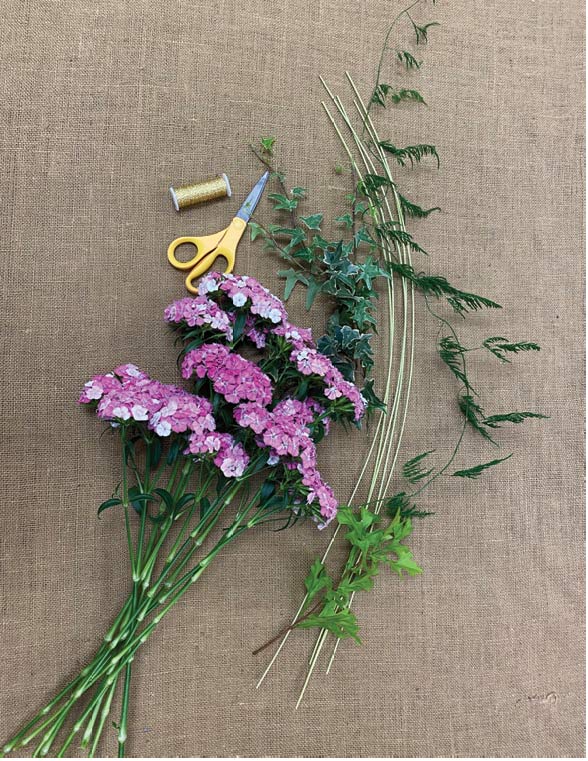
Remove the foliage from the dianthus stems and arrange them into a mass-pattern, asymmetric bouquet through the armature. Place the stems at varying levels for a more casual appearance. Add the oak stem as a color and pattern contrast.
You can bind the stems with a ball of bullion wire, but be sure to prepare it before construction, using about 20 yards. Apply an anti-transpirant spray to all plant material surfaces, and place the design in water until presentation.
Door Decoration or Pew Marker
Floral designers need easy and quick design techniques in their repertoire. This little arrangement illustrates how a multicolor container can lend variety to an overall design when using one variety of cut flower. This arrangement may also appeal to farmers market shoppers at Easter or Mother’s Day.
Tear bits of colorful tissue paper into roughly 1- by 2-inch pieces. Using a small glass jelly jar, cover the container with school glue and add the tissue paper segments. Smear additional glue over the paper and allow to dry overnight. Some designers like to use a clear coating of shellac or similar liquid or spray to provide a waterproof seal to the piece.
We used about four lengths of paper-covered wire as a hanger, winding and tightening it to the jar’s threads for security. Add a secure loop for hanging the jar.
Fill the container about halfway with flower food solution. The flower cluster consists of five dianthus and one ivy stem (about 20 inches long) formed into a hand-tied bouquet, bound with paper-covered wire. Once the design is installed, wind the ivy around the outside edge of the bouquet and along the wires to the back of the design.
If used as a pew marker, multiple lengths of paper-covered wire can be wound around the pew for hanging the jar. Ribbon or string can also be used for suspending the design. We recommend testing the design on-site ahead of the wedding to ensure security and beautiful appearance.
At the end of the wedding, an appointed wedding guest can retrieve the designs from the ceremony site and transport the floral jars to the reception for use as centerpieces or favors.

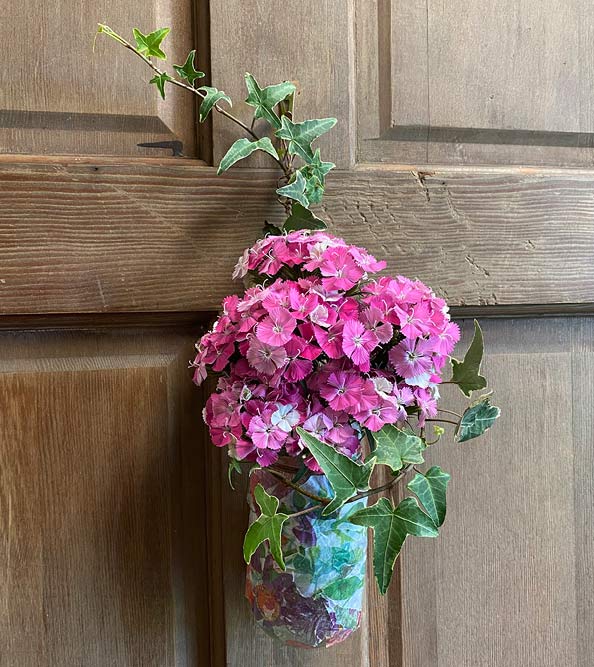
Table Centerpiece
This table centerpiece is made with eight stems of dianthus and one stem of plumosa fern. A log cross-section, approximately 8-10 inches in diameter and 1 inch in thickness, was drilled with eight holes to accommodate bamboo skewers. Time spent on the creation and assembly of these designs is greater at the beginning stages due to the construction of the “container.” Once this step has been completed, fresh floral designing moves swiftly.
You can further prepare the container by binding four 1-inch-long water tubes to the skewers with beige rubber bands. You will not need the flexible plastic tops that normally accompany packages of water tubes. Add loosely bound, paper-covered wire, sisal-covered wire, or other material to lightly mask the bands and provide a vine-like pattern. Set the kits aside until needed.
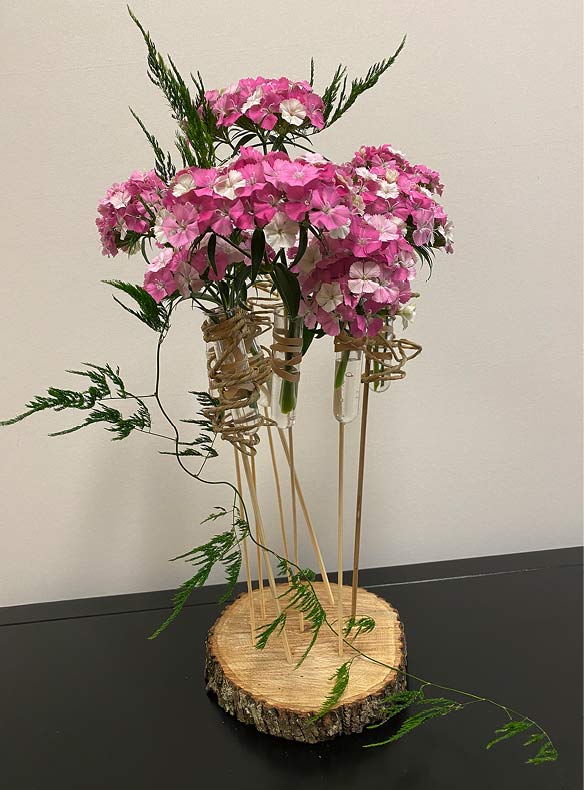
Squeeze bottles with angled necks allow for fast and efficient filling of arranged water tubes.
On a separate table at the reception site, assemble the containers and add water to the tubes. Laboratory squeeze bottles are handy tools to add water to the water tubes. They allow designers to add water with very little spillage. Cut dianthus stems and place them directly into the tubes. Wind a vine through the network of flowers and wire to continue the rustic, countryside theme. Add votive candles in suitable containers around the centerpiece for an evening event. Their light will illuminate the centerpieces’ dynamic lines.
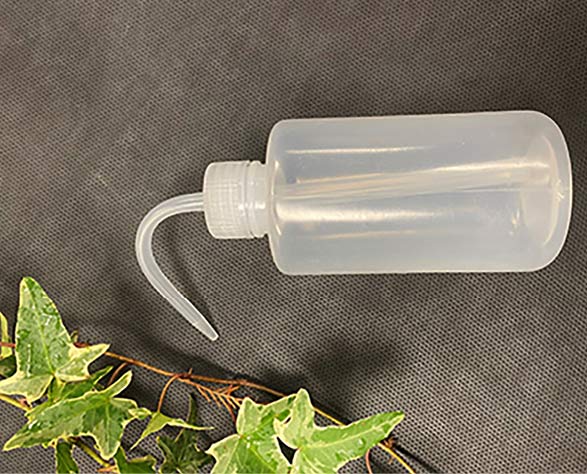
Flower Crown
Flower crowns are easy-to-make designs and are suitable for children, teens, and adults. Crowns are worn by the bride and groom in the Greek Orthodox faith as part of the wedding ceremony. For this design, you will need 12-gauge aluminum wire, bullion wire, and 6 to 12 dianthus stems divided into smaller clusters.
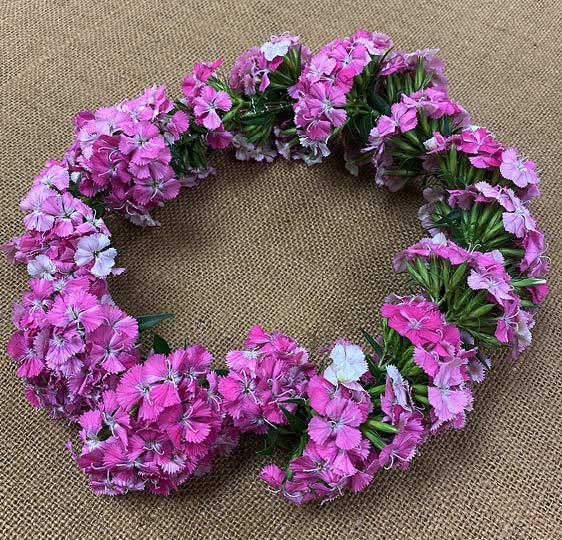
Cut a length of 12-gauge aluminum wire to the necessary size, and crimp the ends into a tight loop. Some flower crowns are small, just 4-6 inches wide, situated on the top of the head or around a bun coiffure. Some follow the crown of the head, while others are worn just above the brow. All are beautiful, and it is best to know what size your client prefers before you start the design.
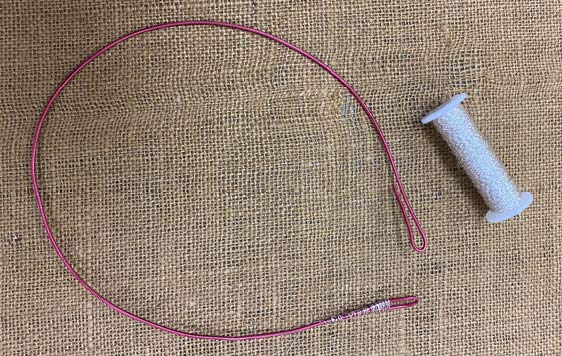
Once the aluminum wire is cut to the correct length, fold the ends over to a length of 1 inch, then over-bind the ends with bullion, leaving loops in place. The loops will be used to secure the finished circle.

Bind the dianthus clusters to the aluminum wire with bullion, creating a snug bind that holds the flowers in place without cutting through them. You can add flowers to the top of the wire so that the back of the crown rests flat against the head. By adding flowers around the wire core, the design will display slightly outward and away from the head, cushioned with flowers. Either method lends beautiful results, and designers should practice both methods.
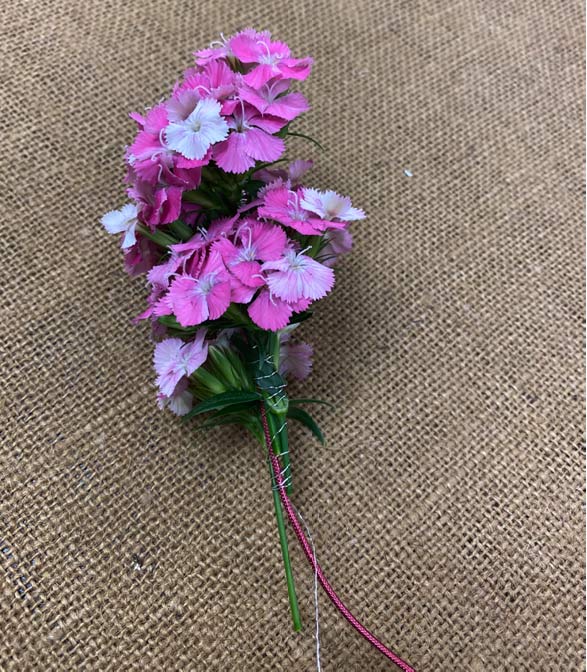
Once the flower binding is finished, overwrap the last stem several times with the bullion, clip it, and then fork the cut end into the network of flowers. Slip one aluminum wire loop into the other, then bend it downward to secure the circle.
Mist the design heavily with anti-transpirant spray, place it in a plastic bag with plenty of air within, and store it in refrigeration until needed. This design can be made and kept this way 3 days prior to the event. Some designers add ribbon to the arrangement before the occasion. It is possible to tack the design to a veil using needle and thread or floral adhesive. When pricing these designs, charge fees comparable to what clients pay for artificial headpieces from bridal salons.
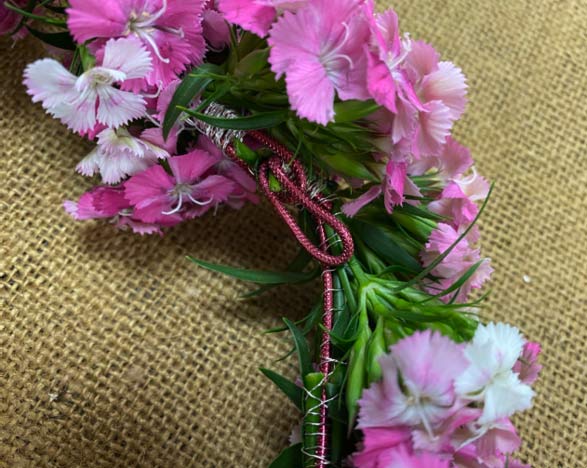
References
Armitage, A.M., & Laushman, J.M. (2003). Specialty cut flowers: The production of annuals, perennials, bulbs, and woody plants for fresh and dried cut flowers. Portland, OR: Timber Press
Butler, S., DelPrince, J., Fowler, C., Gilliam, H., Johnson, J., McKinley, W., Money-Collins, H., Moss, L., Murray, P., Pamper, K., Scace, P., Shelton, F., Verheijen, A. & Whalen, K. (2008). The AIFD guide to floral design. Intelvid, Flourtown, PA.
Byczynski, L. (1997). The flower farmer: An organic grower’s guide to raising and selling cut flowers. White River Junction, VT: Chelsea Green Publishing Company.
Connecticut Agricultural Experiment Station. (2021). Carnation, pinks (Dianthus). In: Plant Pest Handbook. Accessed: March 16, 2021.
Dole, J., & Wilkins, H. (2005). Floriculture: Principles and species. Upper Saddle River, NJ: Pearson.
Hunter, N. (2013). The art of floral design (3rd ed.). Delmar, Clifton Park, NY.
Johnson, J., McKinley, W., & Benz, B. (2001). Flowers: Creative design. San Jacinto, College Station, TX.
Scace, P.D., & DelPrince, J. (2021). Principles of floral design (2nd ed.). Goodheart-Willcox, Tinley Park, IL.
Wood, M. (2007). The seasonal home. Winward, Union City, CA.
The information given here is for educational purposes only. References to commercial products, trade names, or suppliers are made with the understanding that no endorsement is implied and that no discrimination against other products or suppliers is intended.
The authors wish to thank Patrick Broussard, Research Technician, Susan Deblanc, Research Associate II and Facilities Manager, and Corey Wheeler, former Research Technician, MSU Coastal Research and Extension, for floriculture production assistance and David Mills, The Nature of Things, Courtland, MS, for the centerpiece floral container.
Publication 3626 (POD-05-24)
By James M. DelPrince, PhD, AIFD, PFCI, Associate Extension Professor, Coastal Research and Extension Center, and Christine Coker, PhD, Extension/Research Professor, Coastal Research and Extension Center.
The Mississippi State University Extension Service is working to ensure all web content is accessible to all users. If you need assistance accessing any of our content, please email the webteam or call 662-325-2262.



